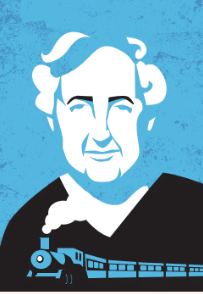The Queen of Crime
Spending most of her time with imaginary friends, Agatha Clarissa Miller’s unconventional childhood fostered an extraordinary imagination. Against her mother’s wishes, she taught herself to read, and had little or no formal education until the age of fifteen or sixteen, when she was sent to a finishing school in Paris. Agatha Christie always said that she had no ambition to be a writer, even though she made her debut in print at the age of eleven with a poem printed in a local London newspaper. Finding herself in bed with influenza, her mother suggested she write down the stories she was so fond of telling, and so a lifelong passion began. By her late teens, she had had several poems published in The Poetry Review and had written a number of short stories. However, it was her sister’s challenge to write a detective story that would later spark what would become her illustrious career. Agatha Christie wrote about the world she knew and saw, drawing on the military gentlemen, lords and ladies, spinsters , widows and doctors from her family’s circle of friends and acquaintances. She was a natural observer, and her descriptions of village politics, local rivalries and family jealousies are often painfully accurate. Mathew Prichard describes her as a “person who listened more than she talked, who saw more than she was seen.” The most everyday events and casual observations could trigger the idea for a new plot. Her second book The Secret Adversary stemmed from a conversation overheard in a tea shop: “Two people were talking at a table nearby, discussing somebody called Jane Fish... That, I thought, would make a good beginning to a story — a name overheard at a tea shop — an unusual name, so that whoever heard it remembered it. A name like Jane Fish, or perhaps Jane Finn would be even better.” How were these ideas turned into novels? She made endless notes in dozens of notebooks, jotting down erratic ideas and potential plots and characters as they came to her “I usually have about half a dozen (notebooks) on hand, and I used to make notes in them of ideas that struck me, or about some poison or drug, or a clever little bit of swindling that I had read about in the paper.” Of the more than one hundred notebooks that must have existed, 73 have survived. They provide a veritable treasure trove of revelations about her stories and how they evolved. The notebooks themselves include previously unpublished material and are an intriguing look into her mind and craft. (Reading text adapted from agathachristie)

